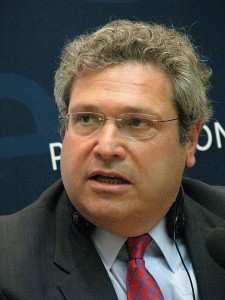Source: Consortium News

By the middle of last decade, the storm clouds were building over the neocons: their "regime change" in Iraq was a disaster; President George W. Bush's "Mission Accomplished" speech was a running joke; news articles were appearing about their "dark side" behavior in the "war on terror"; and the public was tired of the blood and treasure being wasted.
You might have expected that the neocons would have been banished to the farthest reaches of U.S. policymaking, so far away that they would never be heard from again. However, instead of disappearing, the neocons have proved their staying power, now reemerging as the architects of the U.S. strategy toward Ukraine.
A few weeks ago, most Americans probably had never heard of Ukraine and had no idea that Crimea was part of it. But, all of a sudden, the deficit-obsessed U.S. Congress is rushing to send billions of dollars to the coup regime in Kiev, as if the future of Ukraine were the most important issue facing the American people.
Even opinion writers who have resisted other neocon-driven stampedes have joined this one, apparently out of fear of being labeled "an apologist" for Russian President Vladimir Putin. Indeed, it is almost impossible to find any mainstream U.S. politician or pundit who has not fallen into line with the belligerent neocon position on Ukraine.
And the skies ahead are even brighter. The neocons can expect to assert more power as President Barack Obama fades into "lame-duck" status, as his diplomatic initiatives on Syria and Iran struggle (in part because the Ukraine crisis has driven a deep wedge between Obama and Putin), as neocon-leaning Democrat Hillary Clinton scares off any serious opposition for the 2016 presidential nomination, and as her most likely Republican presidential rivals also grovel for the neocons' blessings.
But this stunning turn of fate would have been hard to predict after the neocons had steered the United States into the catastrophic Iraq War and its ugly bloodletting, including the death and maiming of tens of thousands of U.S. soldiers and the squandering of perhaps $1 trillion in U.S. taxpayers' money.
In Election 2006, GOP congressional candidates took a pounding because Bush and the Republicans were most associated with the neocons. In Election 2008, Sen. Hillary Clinton, a neocon-lite who had voted for the Iraq War, lost the Democratic presidential nomination to Sen. Barack Obama, who had opposed invading Iraq. Then, in the general election, Obama defeated neocon standard-bearer John McCain to win the White House.
At that moment, it looked like the neocons were in serious trouble. Indeed, many of them did have to pack up their personal belongings and depart government, seeking new jobs at think tanks or other neocon-friendly non-governmental organizations (NGOs).
More significantly, their grand strategy seemed discredited. Many Americans considered the neocons' dream of more "regime change" across the Middle East -- in countries opposed to Israel, especially Syria and Iran -- to be an unending nightmare of death and destruction.
After taking office, President Obama called for winding down Bush's wars and doing some "nation-building at home." The broad American public seemed to agree. Even some right-wing Republicans were having second thoughts about the neocons' advocacy of an American Empire, recognizing its devastating impact on the American Republic.
The Comeback
But the neocons were anything but finished. They had positioned themselves wisely.
They still controlled government-funded operations like the National Endowment for Democracy (NED); they held prominent positions inside think tanks, from the American Enterprise Institute to the Council on Foreign Relations to the Brookings Institution; they had powerful allies in Congress, such as Senators McCain, Lindsey Graham and Joe Lieberman; and they dominated TV chat shows and opinion pages, particularly at the Washington Post, the capital's hometown newspaper.
Since the late 1970s and early 1980s when they first emerged as a noticeable force in Washington, the neocons had become "insiders." They were both admired and feared for their intellectual ferocity, but -- most important for their long-term survival -- they had secured access to government money, including the slush fund at NED whose budget grew to over $100 million during the Bush-43 years.
NED, which was founded in 1983, is best known for investing in other countries' "democracy building" (or CIA-style "destabilization" campaigns, depending on your point of view), but much of NED's money actually goes to NGOs in Washington, meaning that it became a lifeline for neocon operatives who found themselves out of work because of the arrival of Obama.
While ideological advocates for other failed movements might have had to move back home or take up new professions, the neocons had their financial ballast (from NED and many other sources) so their ideological ship could ride out the rough weather.
(Note: You can view every article as one long page if you sign up as an Advocate Member, or higher).





